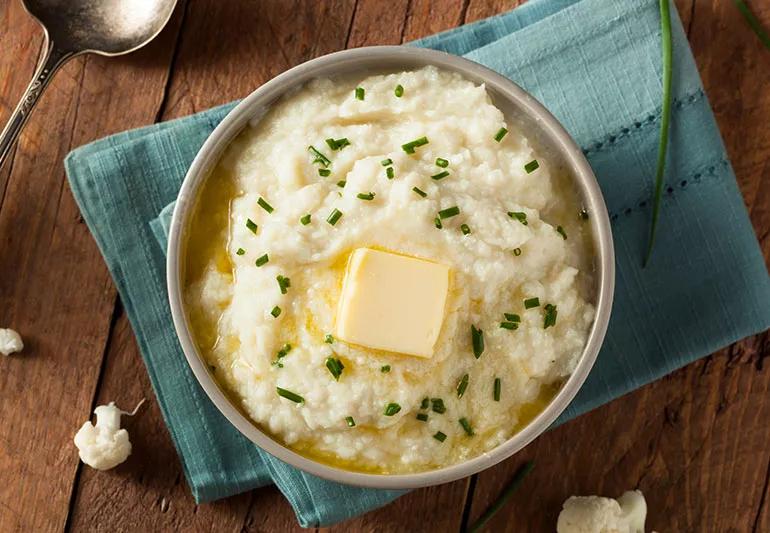You don’t have to sacrifice your favorite recipes for healthier versions

Trying to eat wee bit (or a lot!) healthier? You don’t have to abandon all of your tried-and-true recipes.
Advertisement
Cleveland Clinic is a non-profit academic medical center. Advertising on our site helps support our mission. We do not endorse non-Cleveland Clinic products or services. Policy
Making an ingredient swap can give your meal plenty of flavor but make it healthier at the same time.
“Healthy swaps can really boost your nutrition intake by providing more vitamins, minerals, fiber, healthy fats and protein,” says registered dietitian Julia Zumpano, RD, LD. “Not to mention it can often lead to lower calorie intake.”
Zumpano shows us ways we can make simple ingredient swaps in our meals.
Not ready to completely overhaul how you’re eating? Even little changes can build up to a significant difference in how and what you eat.
And can most ingredients be a one-for-one swap?
“For most swaps, one-for-one can work, but when it comes to baked goods, you may need to make some additional adjustments to ensure a good outcome,” notes Zumpano.
Ready to tweak how you eat? Here are some popular ingredient swaps you can make.
While refined white breadcrumbs add tasty texture to your recipes, they’re loaded with calories and have no real nutritional value.
Instead, use ground or milled flaxseed or almond meal. Both options give you a plant-source of omega-3 fatty acids, while almond meal provides a protein boost along with healthy monosaturated fats.
Many recipes call for half-and-half — but the dairy ingredient is full of saturated fat and added sugar. Fortunately, there are many lactose-free nondairy options out there that are healthier options.
Advertisement
Opt for full-fat coconut milk or coconut cream. Coconut milk is still high in saturated fat, but it’s mostly medium-chain triglycerides (MCTs). MCTs are absorbed for quicker energy. Another benefit? Coconut is dairy-free, making it a great option for those who are lactose-intolerant.
“If you’re trying to cut back on saturated fat, consider light coconut milk or cream or even whole milk or whole milk yogurt instead of heavy cream or half-and-half depending on the recipe,” advises Zumpano.
Your body digests rice quickly, which causes your blood sugar to spike. If you eat a lot of white rice, you may be at a higher risk for Type 2 diabetes.
Consider using riced cauliflower in your recipes. You can either make a DIY version in the food processor or buy pre-packaged options.
“Riced vegetables are a very good source of fiber and a calorie bargain at just 25 calories a cup,” says Zumpano.
Pasta, a refined carb, can cause you to pack on the pounds and raise your disease risk.
Opting for veggies is a gluten-free and low-calorie move. Still craving a “real” noodle? Try those made from legumes for more protein and fiber than traditional noodles.
“Bean-based noodles are a great option, which can really pack on the fiber and protein and keeping you fuller longer; whereas spiralized veggies tend not to be as filling as traditional pasta,” explains Zumpano. “Keep in mind, bean-based pasta provides more carbs and calories than spiralized veggies, so still practice portion control.”
Conventional beef comes from cows that have been grain-fed and given growth hormones and antibiotics.
Grass-fed, pasture-raised meats give you the edge nutritionally. They have 50% more omega-3 fatty acids than meat from conventionally raised animals.
“Grass-fed beef also can provide less saturated fat and calories, especially if choosing 85% lean or greater,” says Zumpano. “It also tends to be a more humane option.”
Though delicious, regular mashed potatoes are high in carbs and calories.
Try mashed cauliflower, which has a similar taste and texture for a fraction of the calories. Another bonus? Cauliflower is loaded with phytochemicals that have anti-cancer benefits.
“Cauliflower is a great source of vitamin C, which helps boost immunity, aids in the production of red blood cells and is essential for DNA repair,” shares Zumpano. “Cauliflower also provides a great source of vitamin K, which is essential for heart and bone health.”
Just hold the mayo! It’s crammed with the bad kind of saturated fat.
Avocados, on the other hand, are nature’s mayo — filled with healthier fats and a delightful creamy mouthfeel. Prefer hummus? You’ll also win with unsaturated fat, protein and fiber.
“Avocados and hummus provide about half the calories and fat when compared to mayonnaise,” Zumpano adds.
Advertisement
And don’t stop here. There are plenty of other healthy ingredient swaps you can make. Think Greek yogurt instead of sour cream, or lettuce wraps instead of taco shells.
The idea is to find a healthier ingredient that tastes or performs the same as the original ingredient.
“Swapping ingredients such as refined grains, saturated fats and added sugars with healthy fats, veggies, legumes and natural sugars really does add up to less inflammation and reduced risk for heart disease, cancer, diabetes, obesity and mental disorders,” says Zumpano.
Advertisement
Learn more about our editorial process.
Advertisement

With a focus on internal cues for hunger and fullness, this eating style may revolutionize your relationship with food

Review the ingredients, watch for sugar and fat, and choose one with the right amount of protein for your needs

A typical recommended balanced diet is half fruits and veggies, a quarter protein and a quarter grains

Foods high in protein, fiber and water can help keep hunger at bay

This quirky food trend is harmless, as long as you’re getting enough protein, fiber and healthy fats

Wrapped or sandwiched, try to choose fillings and condiments that are minimally processed, low in saturated fat and high in fiber

Set yourself up for success by carefully choosing your recipes, storage containers and prepping day

These breaks may have some benefits — but they promote an unhealthy attitude toward food

If you’re feeling short of breath, sleep can be tough — propping yourself up or sleeping on your side may help

If you fear the unknown or find yourself needing reassurance often, you may identify with this attachment style

If you’re looking to boost your gut health, it’s better to get fiber from whole foods